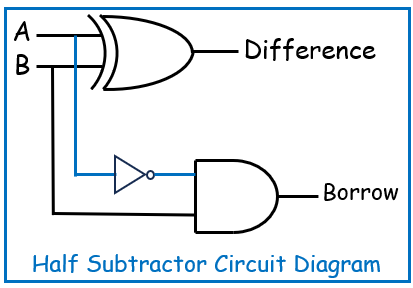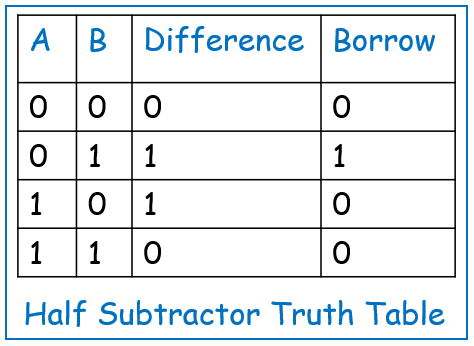In the realm of digital electronics, efficient subtraction operations are just as crucial as addition. The Half Subtractor, akin to its counterpart, the Half Adder, serves as a fundamental component in processing binary numbers. This blog post aims to elucidate the Half Subtractor, its operational principles, components, and significance in digital circuit design.
What is a Half Subtractor?
A Half Subtractor is a digital circuit designed to perform the subtraction of two single-bit binary numbers. Unlike the Full Subtractor, which handles borrow operations for multi-bit subtraction, the Half Subtractor operates without considering borrow. It produces two outputs: a difference bit (D) and a borrow bit (B).
Theoretical Background
Before delving into the Half Subtractor’s intricacies, let’s recap binary subtraction basics:
- 0–0 = 0
- 1–0 = 1
- 1–1 = 0
- 0–1 = 1 (with a borrow of 1)
Components of a Half Subtractor
A Half Subtractor comprises two essential logic gates:
- XOR Gate: Computes the difference bit (D).
- AND Gate: Computes the borrow bit (B).
The logical expressions governing these outputs are:
- Difference (D) = A XOR B
- Borrow (B) = A’ AND B
Here, A and B represent the binary inputs, and A’ denotes the complement of A.
Circuit Diagram
The circuit diagram for a Half Subtractor is straightforward, employing an XOR gate and an AND gate arranged as follows:

Truth Table
The truth table below illustrates the functionality of the Half Subtractor for all possible input combinations:

Applications of Half Subtractor
Half Subtractors find various applications in digital systems, including:
- Building Full Subtractors: Essential for multi-bit subtraction operations, using Full Subtractors constructed from Half Subtractors.
- ALUs (Arithmetic Logic Units): Integral to microprocessor design, where subtraction operations are crucial for arithmetic and logical calculations.
- Binary calculators and digital counters: Used in devices requiring precise counting and data manipulation capabilities.
- Error Detection: Utilized in checksum calculations for ensuring data integrity in communication and storage systems.
Conclusion
In summary, the Half Subtractor plays a pivotal role in digital electronics, facilitating the fundamental operation of binary subtraction. Its simplicity and essential function make it an indispensable component in the construction of more complex digital circuits. By grasping the operational principles and applications of the Half Subtractor, one gains a solid foundation in digital logic design, essential for advancing to more intricate digital systems and applications.